Search
To search for an exact match, type the word or phrase you want in quotation marks.
A*DESK has been offering since 2002 contents about criticism and contemporary art. A*DESK has become consolidated thanks to all those who have believed in the project, all those who have followed us, debating, participating and collaborating. Many people have collaborated with A*DESK, and continue to do so. Their efforts, knowledge and belief in the project are what make it grow internationally. At A*DESK we have also generated work for over one hundred professionals in culture, from small collaborations with reviews and classes, to more prolonged and intense collaborations.
At A*DESK we believe in the need for free and universal access to culture and knowledge. We want to carry on being independent, remaining open to more ideas and opinions. If you believe in A*DESK, we need your backing to be able to continue. You can now participate in the project by supporting it. You can choose how much you want to contribute to the project.
You can decide how much you want to bring to the project.
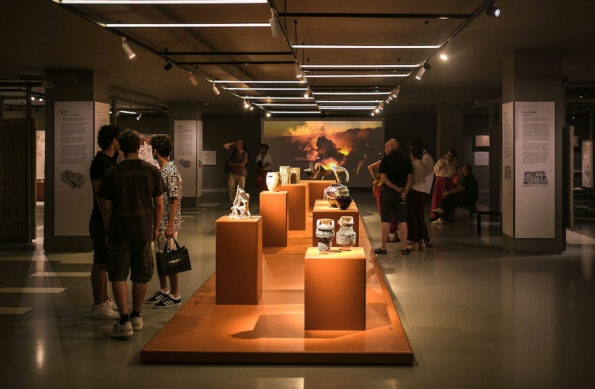
Visiting a biennial dedicated to ceramics on a Greek island requires recontextualization and resignification. Thus, embarking on the inaugural edition of the Biennale of Contemporary Keramics —with a K from Κέραμος (Kéramos)— on the evocative island of Santorini is to embrace a vast cultural and artistic tradition, invoking mythology, a deep connection to the Mediterranean, and its pivotal role as the cradle of Western culture. In this historical and cultural background, the contemporary ceramics biennial opened on June 7th and runs until October 26th, 2024, offering an intriguing fusion of tradition and contemporaneity.
The twentieth-century overemphasis on conceptual art relegated disciplines like ceramics and textiles to the background. However, today, these techniques are being resignified and reclaimed, integrating them innovatively into contemporary art. Indeed, ceramics and their transformative process, turning clay into objects as durable as they are fragile, symbolically reflect resilience and the constant evolution of traditional techniques.
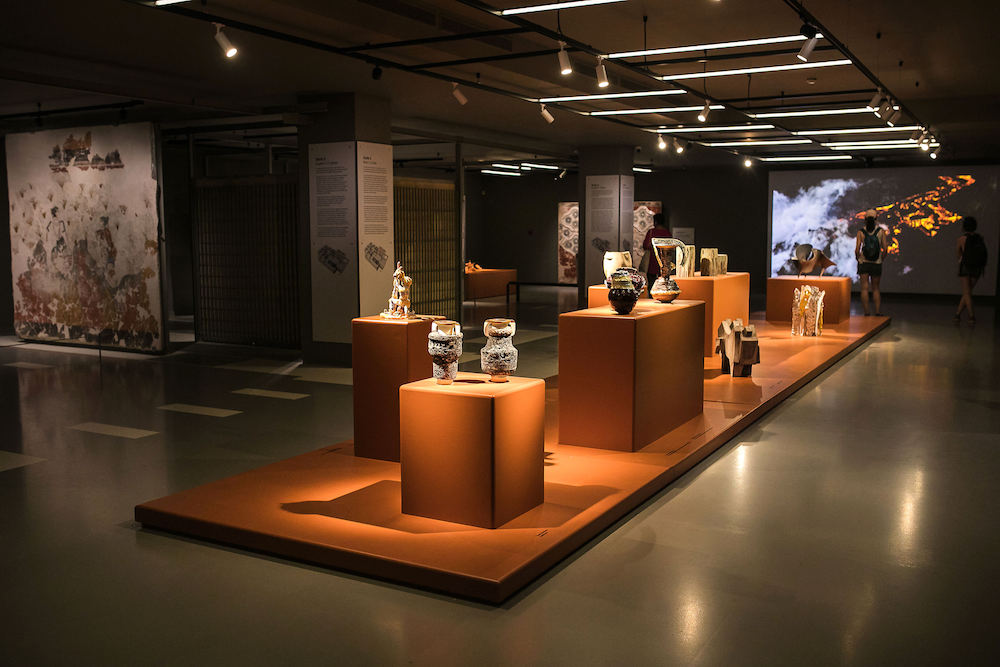
View of the installation at the Biennale of Contemporary Keramics at the Museum of Prehistoric Thera. Photo: Lambros Papanikolatos
Mythological Connection: Pandora and her Jar. Ceramics as a Narrative Medium
Pandora, the first woman created by the gods, was crafted by Hephaestus — the god of the forge — under Zeus’s orders. Her existence was conceived as punishment for humanity after Prometheus stole fire from the gods and gave it to humans. Zeus presented Pandora with a jar (originally, later evolving into the well-known Pandora’s box) with strict instructions never to open it.. we all know the rest. Pandora’s curiosity got the better of her, releasing all the world’s evils: disease, death, pain, and suffering. She hastily closed the jar, leaving only hope trapped inside. Mythologically, the jar symbolizes both the source of humanity’s afflictions and the hope that allows us to endure them. Moreover, as a ceramic object, the jar symbolizes the capacity to contain and release powerful forces. In ancient times, these objects and their paintings, more than utilitarian, were narrative, serving as a medium to tell stories and convey moral and cultural lessons.
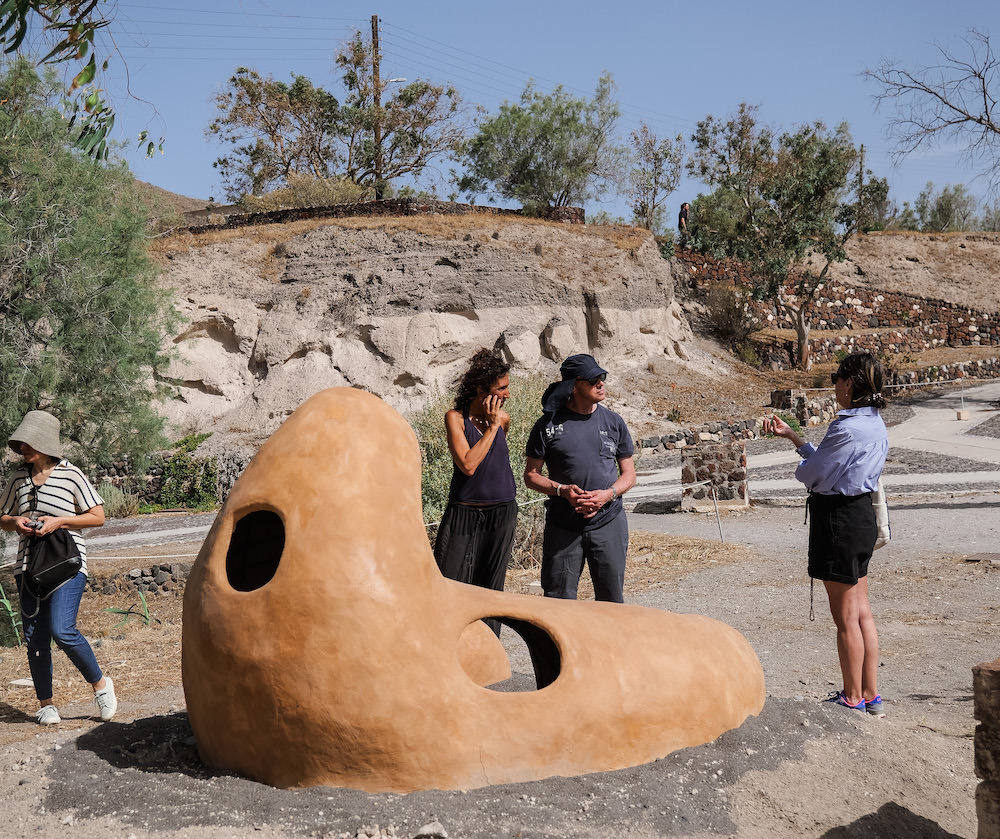
“CLI(T)HERA” by Garnaoui Amyel outside the archaeological site of Akrotiri, Santorini. Photo: Nikos Korakakis
Connection with the Mediterranean: A “Basin” of Contradictions
The Mediterranean, with its crystal-clear yet turbulent waters, seems to reflect the evils unleashed by Pandora. Marina Fokidis, in her text “When Waves Meet” which opens the catalog of the exhibition “The Mediterranean: A Round Sea” presented at ARCO 2023, describes this sea as “an uncontrollable and bittersweet creature […] in the shape of a basin.” Fokidis, one of the curators of the biennial, talks about “an urgent need once again for a more spherical awareness of this very particular region with its mobile and unstable geography and its gravitational pull.” Beyond migratory flows and unsustainable tourism, the Mediterranean represents a unique idiosyncrasy born from the intersection of three antagonistic continents. This multicultural and conflict-laden richness undoubtedly serves as the foundation for the launch of this ceramics-focused biennial.
Santorini and Akrotiri: Connection with Old-Times Modernity
No matter where I am, whether in my native Almería or on the other side of the Mediterranean “basin”, this sea always makes me feel at home: the vegetation, the temperature, the saltiness… The volcanic island of Santorini presents a landscape where earth and fire coexist in a perpetual dance. This environment, shaped by catastrophic eruptions, not only offers spectacular views but also hosts a rich archaeological tradition. At the heart of this volcanic island lies the settlement of Akrotiri, an important Minoan urban center and Aegean port during the Middle and Late Bronze Age (2000-1700 BCE), preserved in time by a devastating eruption around 1600 BCE. Akrotiri reveals an advanced civilization with great urban planning, frescoes, and ceramics.
The inaugural edition of the Biennale of Contemporary Keramics (hereinafter BCK) draws inspiration from Akrotiri, a civilization that expressed itself through the illustrations of its frescoes and ceramics. Building upon the numerous and notable traces left in the region, the biennial seeks to connect contemporary artists with this rich local and multicultural tradition, fostering a process of reciprocal metamorphosis.
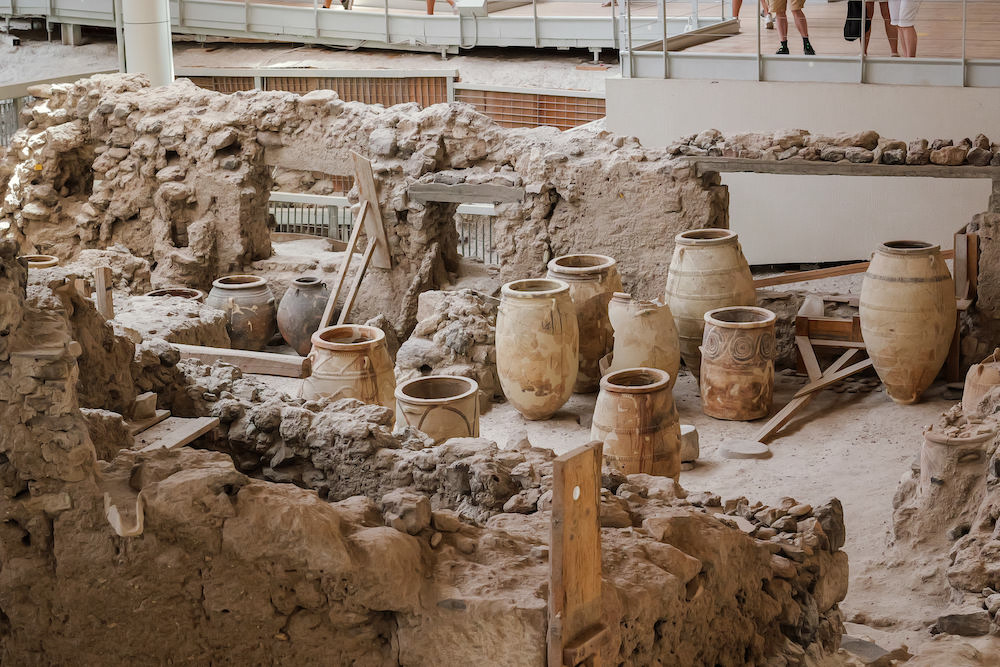
Archaeological site of Akrotiri, Santorini. Photo: Nikos Korakakis
BCK: Fusion of Tradition and Contemporaneity
The convergence between ancient and contemporary ceramics enriches the artistic field and expands our understanding of art as an agent of transformation. Artists combine memory and modernity, tradition and innovation, positioning contemporary ceramics within the discourse of current art. This dialogue underscores the continuity of artistic heritage and reflects on art in constructing and deconstructing our cultural narratives. The BCK exemplifies this trend by linking Santorini’s rich archaeological heritage with contemporary artistic expression. Celebrating the versatility and relevance of ceramics, the biennial not only highlights traditional techniques but also reinterprets them as a source of inspiration in contemporary art.
“In the land of Thera, from the land of Prehistoric Thera”
The BCK, organized by Big Blue Dot, launched an open call that received over 200 proposals. Under the artistic direction of Loukia Thomopoulou and curators Marina Fokidis, Konstantina Daskalantonaki, and Maya Efstathiou from the Museum of Prehistoric Thera — the biennial’s venue — 20 artists were selected. Half of them are Greek, and the other half are international, hailing from other parts of Europe, Asia, the United States, or Japan. These artists created works specifically for the occasion that engage in dialogue with the archaeological pieces of Akrotiri. Titled “Clay Echoes: Unearthing Hidden Narratives,” the biennial builds a bridge between the island’s archaeological past and its vibrant present.
Exhibition Display
The exhibition stands out for the meticulous design by Aristeidis Petrou, where the orange color of the pedestals and platforms evokes terracotta. Careful lighting enhances the ensemble of contemporary pieces in dialogue with the archaeological ones, without overshadowing their presence. The biennial’s works are arranged in various constellations within the Museum of Prehistoric Thera, creating a sort of spatial dynamism.
The biennial’s works coexist harmoniously alongside the murals, objects, and ceramics of Akrotiri, a unique heritage demonstrating the relationships and communications of the island’s ancient inhabitants with diverse cultures, from the Dodecanese, Cyprus, and mainland Greece to Egypt and Syria, offering a transnational cultural perspective. Furthermore, the fusion of the ancient and the new creates a visual tension inviting the viewer to reconsider the relationship between art history and craftsmanship.
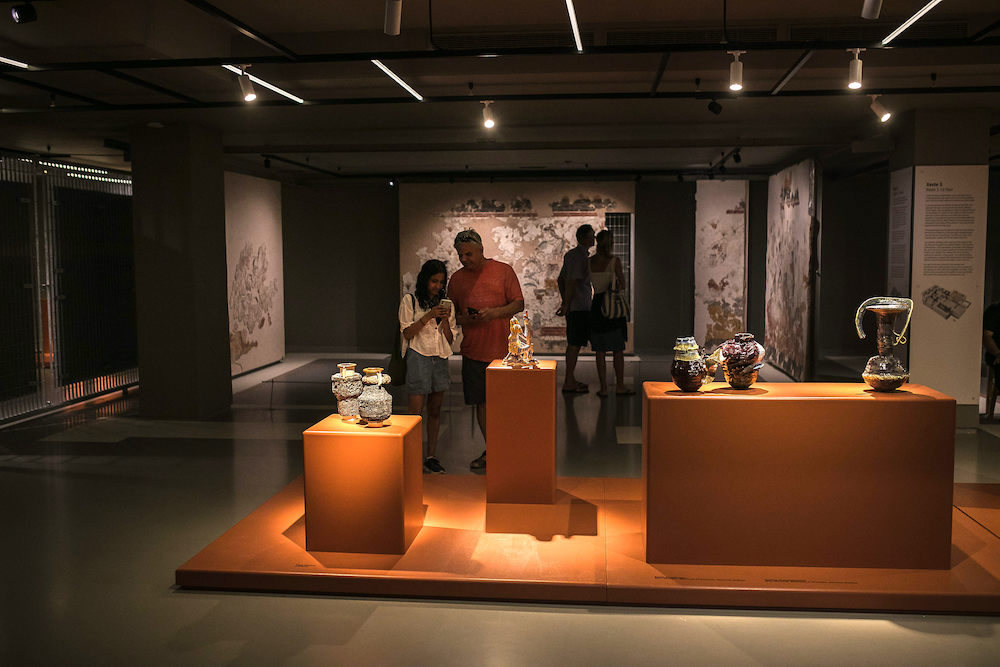
View of the installation at the Biennale of Contemporary Keramics at the Museum of Prehistoric Thera. Photo: Lambros Papanikolatos
Awarded Artworks at BCK
Contemporary ceramics, in dialogue with ancient Greek ceramics, occupies a fertile space of tension between cultural memory and innovation. In this interaction, a dialectical relationship emerges that challenges both time and established conventions. The ceramists participating in the biennial do not merely emulate classical forms; instead, they deconstruct, resignify, and recontextualize these forms to address contemporary issues, transforming clay into a medium for critical expression.
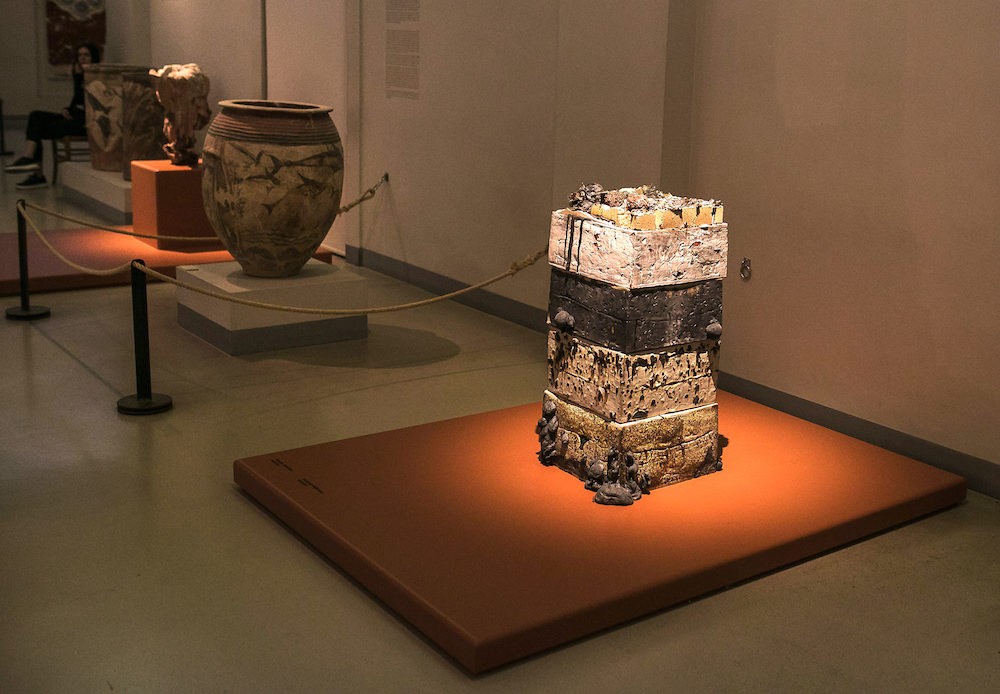
On the right, “Incision” by Giorgos Vavatsis. Winning work of the 1st edition of BCK. Photo: Lambros Papanikolatos
In the context of BCK and its comprehensive vision of the field of contemporary ceramics, an international jury awarded three prizes following a combination of historical analysis, expertise in contemporary art and ceramics, and a detailed examination of techniques and styles. The unanimously chosen winning piece, recognized for its excellence in form, concept, and technique, is “Incision” by Giorgos Vavatsis. Vavatsis creatively employed materials from volcanic areas such as stones, metals, and plastics to weave a narrative spanning human epochs, likening the process to an excavation revealing layers akin to archaeological discoveries. His work represents an artistic odyssey on Earth’s geological history up to the Anthropocene. The process includes collecting geological specimens and contemporary artifacts, integrating them into his ceramic sculptures. This approach highlights the importance of accidents in his experimental methodology, where the unpredictability of the process is essential to the final result.
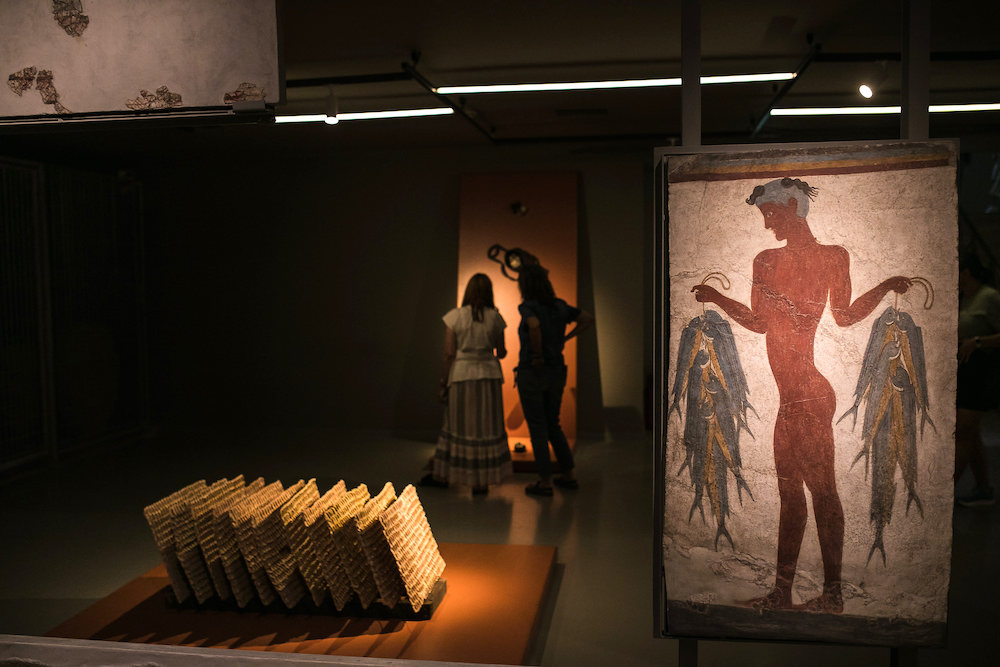
On the left, “Weight (limit of excavation)” by Em Irvin. Photo: Lambros Papanikolatos
The second and third prizes were respectively awarded to American Em Irvin and German Ule Ewelt. Em Irvin describes her practice as a resonance of physical and invisible barriers. Her sculpture at BCK, as conceptual as it is performative, explores temporality and human presence. She has created a series of panels containing her fingerprints, reflecting the persistence of human marks over time. On the other hand, Ule Ewelt focuses on the relationship between humans and animals, imbued with mythological associations. Inspired by the ancient frescoes of Akrotiri, her work depicts antelopes, and her installation at the Museum of Prehistoric Thera is one of the most striking as it is placed directly in front of the mural that inspired it, capturing its essence and establishing a connection with the distant past.
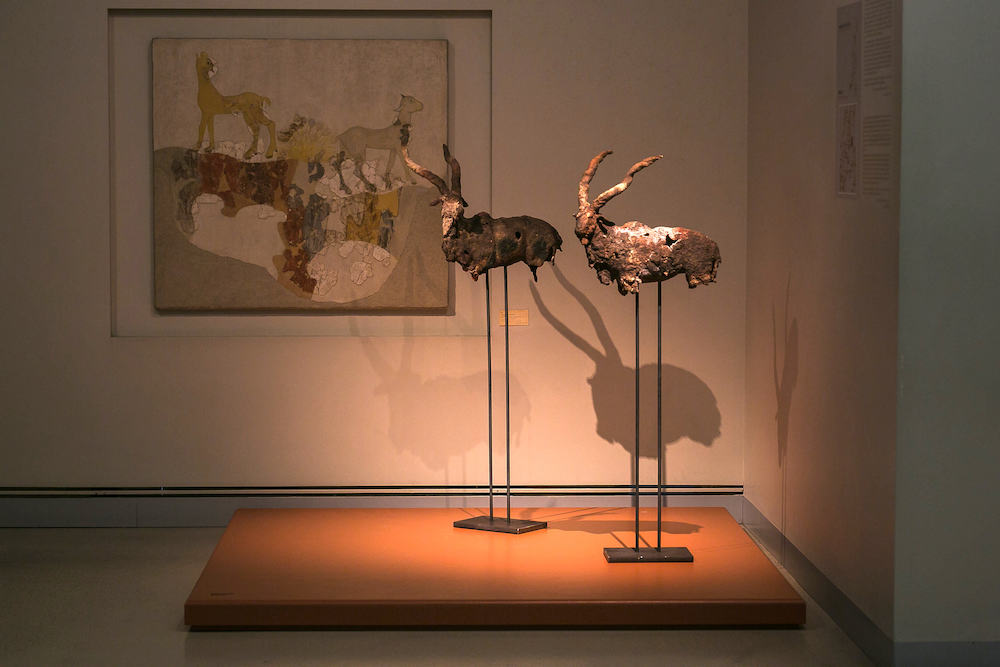
“θηρίον” by Ule Ewelt. Photo: Lambros Papanikolatos
Other Noteworthy Artworks: Nature, Identity, and Philosophy
While some works are decidedly and determinedly impersonal, others evoke diverse cultural and autobiographical associations. For Simon Manoha, expanding the semantic field and cultural dimensions of alterity to encompass nature is crucial, allowing each part of the world to express itself as it is, not through human eyes. His work “Kopfschmerzen” pays homage to the philosophy of Emmanuel Lévinas, where alterity is something over which one has no control, a gift that expresses itself in its own way. Manoha collects clays, stones, and river sand from the surrounding mountains to create clay that better reflects his environment. He uses natural glazes by grinding minerals from the mountains and creating ashes with native plants, developing them together. Finally, he shapes nature through an empty state of mind.
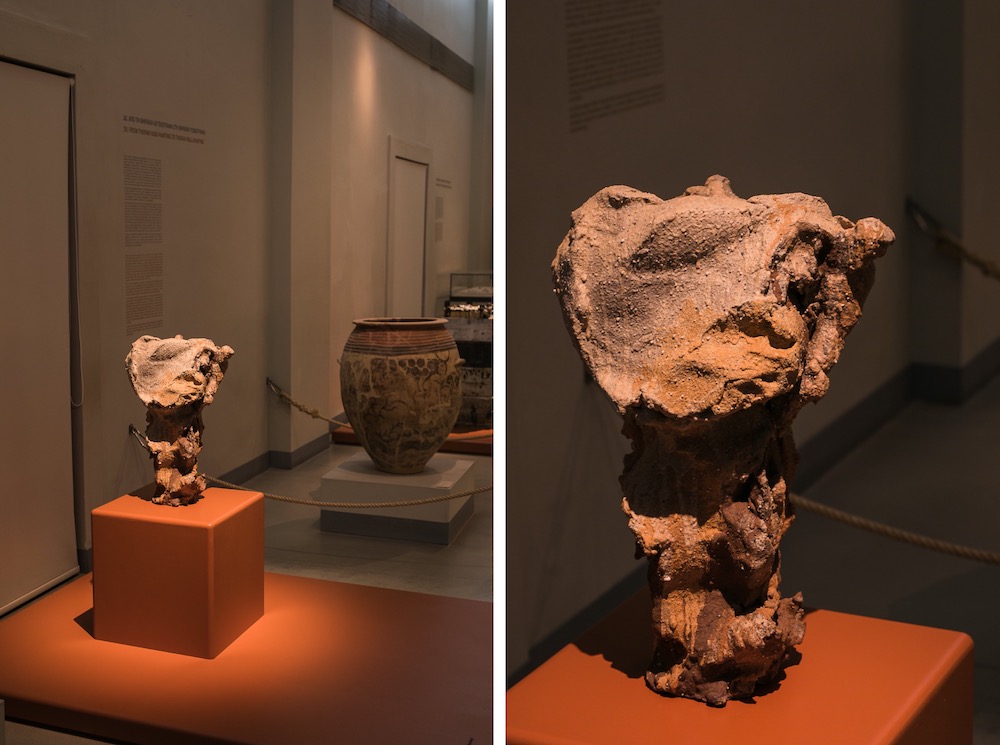
“Kopfschmerzen” by Simon Manoha. Photo: Lambros Papanikolatos
On the other hand, Iosifina Kosma‘s work also focuses on nature. Her hand-built piece captures the essence of the life cycle with an organic form reminiscent of ancient representations of flowers and nature in general. The surface is meticulously carved with grooves and small holes, then glazed to reflect the colors of the volcanic landscape. Kosma’s sculpture is a testament to the delicate balance between precision and spontaneity in ceramics.

In front “Blossoms of Thera” by Iosifina Kosma. Photo: Lambros Papanikolatos
Yena Young, meanwhile, delves into the intricate tapestry of social and cultural identity intertwined with personal narratives and historical contexts. Her work highlights the relationship between spatial environments and emotional subtleties, creating an imaginative microcosm where small worlds become a space for creativity. Perspective and scale, the interaction between the grandiose and the intimate, serve as a metaphor for the multiple layers of the human experience.
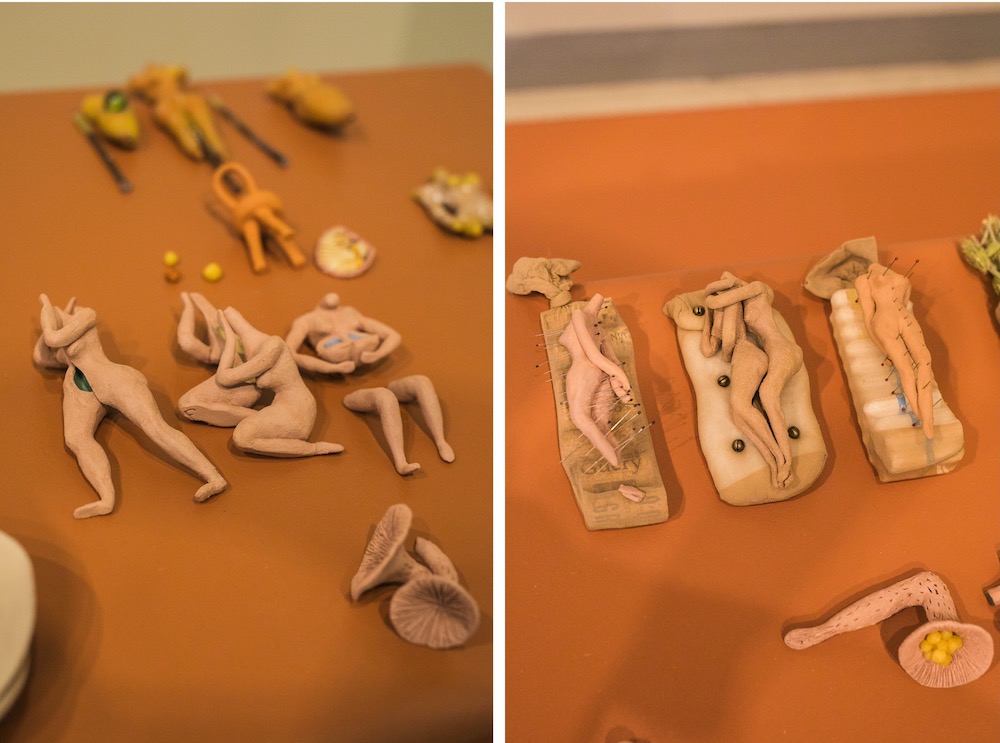
“Utold Stories, Figurines of Akrotiri” by Young Yena. Photo: Lambros Papanikolatos
Themes such as identity and nature are addressed through a formal language that is both reverential and disruptive. In this context, ceramics become a vehicle that uses the language of the past to articulate contemporary concerns. The transformation of the utilitarian functionality of ancient ceramics into contemporary commentary highlights, once again, the power of art to reflect and question society.
On the Biennialization of Contemporary Art
In a context where cultural events like biennials abound, some stand out for their impeccable presentation but lack emotional depth, while others firmly focus on the concept and history of art but lose momentum in aesthetics. The BCK manages to balance both facets: it establishes links between past and present and presents a highly curated artistic display full of cultural references that articulate a biennial destined to last.
BCK: an Itinerant and Decentralized Biennial
Unlike many biennials held in major cities, the BCK adopts a decentralized and itinerant approach. Each edition will take place on a different island, allowing each location to inspire the theme and narrative of the exhibition. On this occasion, as we highlighted, Santorini, with its rich archaeological and cultural heritage, becomes the perfect place to initiate this journey.
The Biennale of Contemporary Keramics is conceived as a work-in-progress that invites protagonists from the new global and multicultural art scene to filter their identities through the magical and archaic medium of ceramics. By experimenting with multicultural encounters and exchanges, the BCK takes a positive stance against the prevailing trend towards global cultural uniformity and reinterprets territorial context as a “glocal” space of reciprocal flow and connection.
Thus, the long-term vision is for this biennial to act as a catalyst for Greek culture, connecting national artistic production with the international scene and unleashing new narratives through ceramics. We are already looking forward to the second iteration!
(Cover image: View of the installation of the Biennial of Contemporary Keramics at the Museum of Prehistoric Thera. Photo: Lambros Papanikolatos. All images courtesy of BCK)
BCK 2024, Biennial of Contemporary Keramics, until October 26
Museum of Prehistoric Thera/Ephorate of Antiquite of Cyclades
Fira, 84700, Thera (Santorini)
All info at oficial biennale webpage.
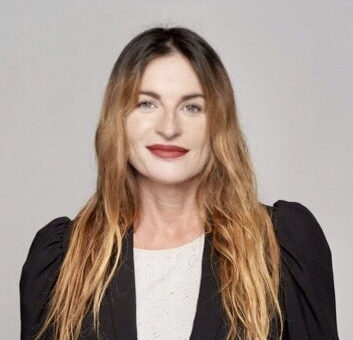
María Muñoz-Martínez is a cultural worker and educator trained in Art History and Telecommunications Engineering, this hybridity is part of her nature. She has taught “Art History of the first half of the 20th century” at ESDI and currently teaches the subject “Art in the global context” in the Master of Cultural Management IL3 at the University of Barcelona. In addition, while living between Berlin and Barcelona, she is a regular contributor to different media, writing about art and culture and emphasising the confluence between art, society/politics and technology. She is passionate about the moving image, electronically generated music and digital media.
Portrait: Sebastian Busse
"A desk is a dangerous place from which to watch the world" (John Le Carré)